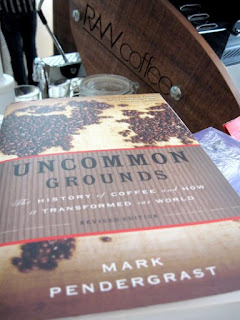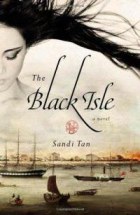first published in
The Malaysian Insider, 22 November 2012
I bought this book with the hope of learning all that's interesting about coffee.
I wish it had been written in an interesting way.
Mark Pendergrast's encyclopaedic and scholarly
Uncommon Grounds packs a lot of history, geography, a bit of chemistry and assorted trivia in what reads like a memoir of the black brew, complete with illustrations, ad posters, photos and graphical material.
From the fabled tales of its discovery to the rise of the "third wave", coffee has played a bigger part in our modern history than even the most caffeine-literate among us would dare to imagine. Real wars, trade wars, gender wars, civil wars, ad wars, and the colourful characters that pioneered the early coffee trends.
Even sex was part of this rich history. One legend says a Lt. Col. Francisco de Melo Palheta from Brazil charmed a few coffee seedlings from the First Lady of French Guiana in the 18th century. Today, Brazil is considered the world's largest producer of coffee.
Factually voluminous
Points of interest in this book include:
• Clash of civilisations. Over 400 years ago, in a bid to ban what was then also known as a "Muslim drink", Pope Clement VIII was given a taste of coffee, and was hooked. He reputedly said he'd baptise the "delicious" drink to make it "a truly Christian beverage." Thank goodness there was no Internet or social media back then, or history might have been different.
• Kopitiams in England. In the 1700, coffee houses were also called "penny universities". Over a one-penny cup of coffee, one can listen in on discussions that could go on for hours. The topics varied according to the clientèle, and no two coffeehouses served the same group, apparently. Nowadays, coffeehouses can be so noisy, you can barely hear
yourself speak. And good luck trying to get a cuppa for a penny.
• Yankees once knew squat about coffee. For a long time, it seems nobody in the US knew how to properly select, roast and brew the beans. Nor did they know or learn to love the taste of pure coffee. What they added to 'improve' the flavour chills the blood. A partial list (around the 1880s) includes such adulterants as chicory, chrysanthemum seeds, coal ashes, dog biscuits, malt, parsnips, rice, sawdust, wheat and wood chips. One's glad they got much better since then.
• Coffee substitutes. With all the things used to adulterate coffee around that time, small wonder it made some people sick. In 1895 businessman Charles William Post came up with a 'healthier' substitute. Post was also a savvy marketeer of his roasted cereal coffee substitute, "Postum", using ads that struck a chord with his audience. Ironically, Post
also drank coffee, which may or may not have stressed him out or driven him to suicide.
• Cupping was a guy sport, until... Erna Knutsen was probably the first female ever to enter the male-dominated cupping room, and became a specialist in high-end coffee beans. She also gave the name "specialty coffee" to her niche. The term appeared in the
Tea & Coffee Trade Journal in 1974.
• Beans in one basket? Bad idea. As a major producer of coffee, the effects of
frost on Brazil's coffee crop is carefully watched. Substantial crop damage means higher prices. But as this slack is taken up by countries such as Vietnam, there's the risk of a
coffee glut instead.
If
Uncommon Grounds were sampled like a coffee, one notices almost immediately a distinct academic dryness that registers heavily on the senses with just the slightest touch of fruitiness. Very little of the blurbed wit is there, except for the footnotes which elicit the briefest of sparkles before dissipating completely. What comes on most strongly are the pungent earthy notes of the deepest sun-deprived alcoves of a library or archival hall.
The author appears not to take sides or present a skewed point of view, hence the neutral, uninteresting tone which makes going from cover to cover almost impossible. Interesting it may be, all that socio-politico-economic stuff just flew over my head, putting me - ironically - to sleep after a couple of chapters' worth. These parts deserve a revisit when the mind is more lucid.
But you'll learn lots of stuff about coffee, like how instant coffee is made. I'm now more determined than ever to avoid it, unless it's the finer brands and only when making milkshakey novelty coffee drinks at home.
A bitter brew for some
That blood had been spilled over coffee may astonish some. "Blood coffee" has been around for a while; Pendergrast quotes the example of Idi Amin, who financed his reign of terror with profits from Ugandan coffee exports. A news report
spotlights criminal raids on Kenyan coffee farms.
But consider this: A news report
cites the International Coffee Organisation (ICO) as saying: "The value of total exports in calendar year 2011 is currently forecast at $23.5 billion for a total volume of 102.4 million bags compared to US$16.7 billion for a volume of 96.8 million bags in 2010." Globally, over two billion cups are drunk every day, most of that in developed nations.
In short, coffee is big business. Pendergrast once said that it's the second most valuable legally exported commodity in the world after oil, a statement I first heard in what I think is the 2005 documentary,
Black Coffee. Though he seems to have disavowed that assertion in this edition, it's occasionally repeated on the web.
Considering how tightly coffee is woven into the fabric of our lifestyles, I don't think much that can be done at the moment about some of our money trickling down to these unsavoury enterprises. Let someone else take up that Facebook campaign.
Sip, don't gulp
Perhaps it's because my love and experience for coffee has yet to reach the rarefied heights inhabited by the caffeinated cognoscenti that I failed to see the finer points of Pendergrast's
Uncommon Grounds.
There's so much in this book, it'll take a while for everything to percolate down to one's subconscious. I just know that I'll be sipping my next good cuppa Java, Brazilian or Colombian with more care.
So maybe I did it wrong. Maybe this book should be sampled in small doses and not gulped down with pinched nose like bitter medicine. It is as complex as the beverage it profiles. The chronological order of the chapters makes that easier but sometimes, one can get carried away and just turn page after page after page after....
...think I'll just stop here and wrap this up.
Even after internalising the whole book, one gets the sense that it's just scratching the surface of the bean. Coffee is still with us, and will continue to evolve along with - and shape - civilisation as we know it. That is, if climate change doesn't
wipe out coffee first.
Time markers have been added to the "points of interest" in this version.
Photos taken at Artisan Roast TTDI at 4, Jalan Rahim Kajai 14, Taman Tun Dr Ismail, 60000 Kuala Lumpur and RAW Coffee @ Wisma Equity, 150 Jalan Ampang, 50450 Kuala Lumpur
Uncommon Grounds
The History of Coffee and How It Transformed Our World
Mark Pendergrast
Basic Books (2010), revised edition
424 pages
Non-fiction
ISBN: 978-0-465-01836-9

























